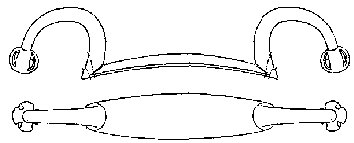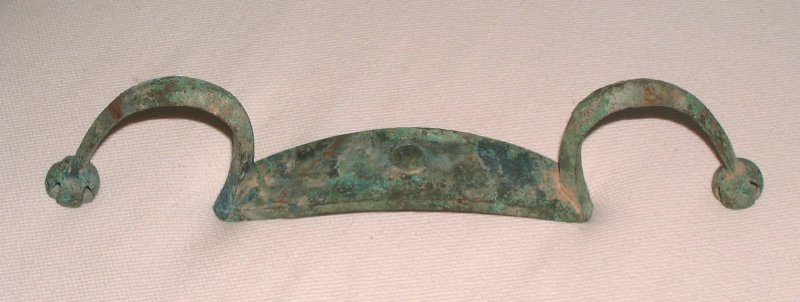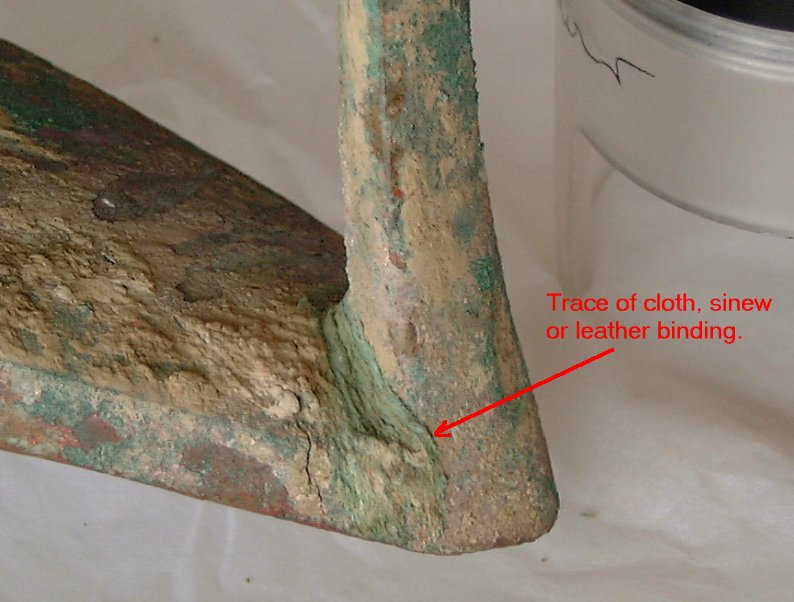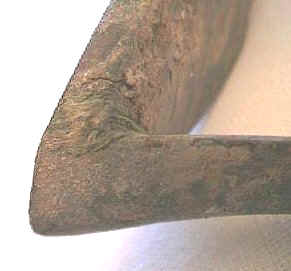
Thingies Up-close and Personal
Follow-up Correspondence

From: Adam Karpowicz Sent: Saturday, February 19, 2000 9:55 AM Subject: Re: thingies
> > 1. Do you have an illustration of a chariot with a driver, preferably >with horses?
Try the attached chariot.gif. Note: this illustration cannot be published.
My understanding is that at a later period, three soldiers manned the chariot: a driver in the middle, a bowman to the right and a halberdeer to the right. In the Shang burial, there were twohuman sacrificial victims in the body of the chariot. (You can see them in the drawing.) > > 2. You mention a bow hook from Warring States Period: where exactly was >it found in relation to the driver? Any illustrations? In one version, to the left of the driver's seat. But that was a different type of cart - not a war chariot. Please see attached photo. xbowdetl.jpg > > 3. What is the circular broken line in the drawing of the finds at the >end of your article? Some decorations attached to the outer edge of the railing of the chariot. See the railing in the top diagram in chariot.gif >
From: Adam Karpowicz Sent: 19 February 2000 10:51 To: Stephen Selby Subject: Re: thingies
Thanks. How tall in your opinion would be the railing? It seems quite low, no more than 3 feet. I understand the soldiers were standing in the chariot all the time.
From: Stephen Selby Sent: 19 February 2000 16:38 To: Adam Karpowicz Subject: RE: thingies
I have no measurements, but it could not have been more than 60 cm.Too low, in my opinion, to support one theory: that the thingies were to tie to archer to the railing to support him while he loosed off.
From: Adam Karpowicz Sent: 19 February 2000 To: Stephen Selby Subject: Re: thingies
Stephen: I believe I have a solution. 1. Thingies appear to be a personal property of the driver/soldier, since one thingie is found together with other such personal items (knives etc.). One thingie per one soldier. 2. Thingie is unlikely to have anything to do with archery. Too large and heavy, your crossbow idea was better, but can be dismissed, as you explained. There is a mention of a metal bow straightener in Indo-Persian archery, shaped as an Arabic letter "J" (if I remember correctly, described in Pant), but too different than thingie. Thingie could not serve such purpose due to its different shape and (unnecessary) weight. 3. The chariot railing is very low (presumably to allow for more room for the soldier, I think). It's width is no more than 2m, depth 1m (as in the drawing). I believe it was made for one soldier/driver. Two of them side by side (let alone three!) could not easily shoot arrows, throw spears etc. One driver/soldier would have enough room, and enough distance from the moving (and dangerous!) wheels. He could store supplies at the sides too. The depth of 1m is not enough for another soldier at the back. 4. It is almost certain the soldier had to stand while driving. He could shoot effectively etc. only in the standing position. 5. Driving a chariot, one needs reins for the horses. The reins come from the horses and converge at the soldier. How can one hold reins and fight at the same time? In horseback archery there are special ways to do that, but there is only one horse to control. The driver, to control the horses, would need to hold the reins rather firmly in one/two hands all the time. 6. The thingie was found at the front of the chariot. 7. It is a heavy and strong item. Based on the above, I believe the thingies were tied to the soldier's belt at his waist. The reins would be hooked over the projections, easily accessible in case the horses needed to turn, stop etc. The base of the thingie is curved to follow a contour of the soldiers belly and wide enough not to drop down when tied. Traces of lashing were found at the junction of the base and the projections. Of course the bells or no bells made no difference, just an embellishment. Also the base would not need to be hollow, although it would be helpful for stability. Do not forget who solved this mystery 8^) Seriously I believe there is logic in this, unless there are other facts I do not know.
Letter of January 2002
Ah! Them thingies!
My interest in 'Thingies' continues unabated. You will recall my article from 2000, Thingies Up-close and Personal and the Follow-Up Discussion that ensued on the Discussion Forum. Since that time, ATARN readers have emailed me with their ideas.
In the meantime, I have been scrutinizing archaeological reports of new excavations of thingies. Several have appeared in the past two years. I have also purchased a further pair of thingies which are in their original, excavated condition and provide some interesting clues.
Archaeological reports have offered no new
evidence of thingies in the context of bows and arrows. However, a good report
was published in 'Archaeology' ('Kaogu') 2000.7 p. 13 of an excavation of a
Shang/Zhou grave at Tengzhou in
Shandong. Grave #4 contained a well-preserved two-horse chariot burial with a
single human skeleton in the usual position under the rear of the chariot. The
thingie in this burial was at the forward edge of the platform of the chariot,
and not associated with the corpse or any archery items. It was, however,
associated with a dagger axe and a number of belt-related items.
This consistent relationship between thingies and belt items suggests that Adam Karpowicz's view in his contribution in February 2000 were correct -
"... ...Based on the above, I believe the
thingies were tied to the soldier's belt at his waist. The reins would be hooked
over the projections, easily accessible in case the horses needed to turn, stop
etc. The base of the thingie is curved to
follow a contour of the soldiers belly and wide enough not to drop down when
tied. Traces of lashing were found at the junction of the base and the
projections."
His comment reminded me at that time of some very large thingies I have seen, which could hardly have been associated with a bow, but would have nicely fitted a large charioteer's belly.
Last year, I purchased two more thingies. Here are photographs of them.



 These
traces of bindings suggest a rather flimsy attachment to whatever was
underneath. Why would that be? The answer must be that a driver wanting to hang
the reins of two galloping horses would be keen to ensure that in case of an
accident, he was not firmly attached to the reins. A leather thong at the
position indicated in the photograph above would be sufficient to keep the
thingy firmly on the belt, but break off if the driver started to be dragged. It
is similar to the idea that if you tie a horse by a lead-rein in a stable, you
tie the lead rein to a string, and not directly to a bar, in case the horse
bucks in a panic and breaks its jaw.
These
traces of bindings suggest a rather flimsy attachment to whatever was
underneath. Why would that be? The answer must be that a driver wanting to hang
the reins of two galloping horses would be keen to ensure that in case of an
accident, he was not firmly attached to the reins. A leather thong at the
position indicated in the photograph above would be sufficient to keep the
thingy firmly on the belt, but break off if the driver started to be dragged. It
is similar to the idea that if you tie a horse by a lead-rein in a stable, you
tie the lead rein to a string, and not directly to a bar, in case the horse
bucks in a panic and breaks its jaw.
An ATARN reader recently drew my attention to a British Museum web page (http://www.ancientegypt.co.uk/pharaoh/story/main.html) with an illustration of an ancient Egyptian charioteer, Pharaoh Ramesses II, whose chariot reins were attached to his belt (although no thingies are in evidence.)
Unnecessary when riding a horse because other aids are available, thingies would be indispensable if you were a charioteer on a chariot drawn by two horses with simple reins. You would be able to wrap the left rein pair on the left hand horn of the thingy and the right pair on the right. You could keep mouth contact while your hands were engaged elsewhere, steer to left or right by rotating your hips and regain the reins quickly.
Someone needs to try this out. Not me, thanks. And at your own risk.